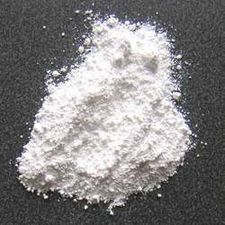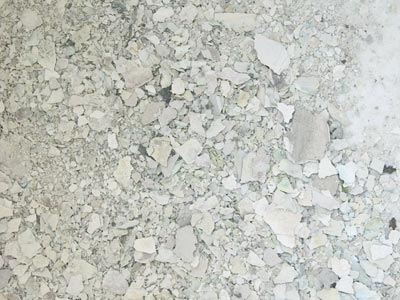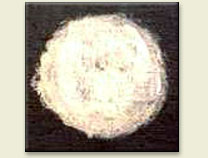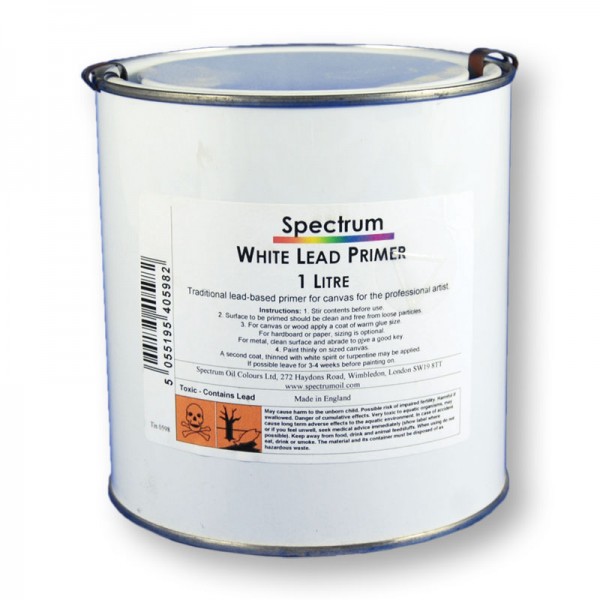White lead
- Basic lead carbonate
- Cerussa
- Whitewash
- Hydrocerussite
- Tribleidicarbonatdihydroxid
White odorless powder
Fixed
6.14 g · cm -3
Decomposition above 400 ° C.
Insoluble in water
Risk
Template: Infobox chemical / molecular formula search is not possible
White lead, 2 PbCO3 · Pb (OH ) 2, is a basic lead carbonate and since ancient times an important white pigment.
Properties
White lead is resistant to light, has a very high opacity, depending on the binder has a beautiful shine. Due to the lead content, it is very toxic and darkens by the formation of deep black lead sulfide after. Particularly susceptible it is in aqueous binders, such as watercolors. Hydrogen sulfide is ubiquitous in traces in the air and the aging pigment over time. For the same reason it is unsuitable for sulfur- containing binders and sulfur-containing colored pigments such as ultramarine, vermilion, orpiment.
The toxicity of lead white has been known since ancient times. Starting from France, the pigment properties of zinc white were detected from the mid-19th century. Since the beginning of the 20th century, blanc fixe came as a white pigment used, so that the originally " only" white lead lost its importance. Since the 1960s, titanium white is produced in large quantities worldwide. In the paint and plastics industries lead white has no meaning anymore. Compared with white lead artist colors has titanium white with its chemical and physical properties have significant disadvantages.
Advantages and disadvantages to other white pigments
- Lead white dries very quickly because lead compounds catalyze the curing of drying oils. Titanium White dries slowly, depending on the binder.
- Stained mixtures with titanium white give cold tones. The reflectance of white lead goes down already in the visible ( blue ) area, it has a yellow tinge. Titanium White remitted almost entirely up in the ultraviolet region and as a consequence it seems cold. White lead, however, can be an excellent mix of transparent and opaque pigments.
- Is white lead because of its crystal structure with a soft pigment. The other hand, titanium white (also depending on the crystal structure of rutile or anatase) a hard pigment ( Mohs hardness 6 ), it can also dry to carve hardened steel. Thus, white lead can better rub, edit to finer grain sizes. Titanium dioxide pigments generally have a binding system matched to the surface functionalization. The primary particle size is 220 nm to 300 nm, so that usually a simple sufficient dispersion to achieve a good hiding power.
- Pure TiO2, especially anatase pigment under UV light shows a photocatalytic effect. This leads to faster chalking. Modern titanium dioxide pigments have a high finish, which almost completely suppress this effect.
- Zinc white (ZnO is white) can be a substitute for white lead. In oil paints zinc white covers less than white lead. Blanc fixe is used to replace less suitable. In contrast to white lead and zinc white, the refractive index of baryte differs only slightly from that of most binders.
Zinc sulfide ( ZnS is also white, but with a hint of green ) is not suitable as oil paint. In Chalk ( soft white limestone) knows the values are even closer, so chalk is used as a transparent white.
Production
White lead is an artificially produced pigment. A rare mineral, it is known under the name Hydrocerussite ( a Bleihydroxycarbonat ).
In the ancient and medieval writings, the production is described as follows: In a vessel sheets of lead or lead pieces are placed together with a cup of vinegar and then buried under a pile of manure. The lead is thus exposed to vinegar vapors and carbon dioxide and is held by the putrefaction in the manure at a constant temperature. After a few weeks, then forms on the lead plates of a white substance, white lead.
In another historical process metallic lead is also exposed to the action of vinegar vapors and carbon dioxide. An example is the Dutch Loogenverfahren. The oxidation Loogen are spaces in which up to ten tons of lead plates, wrapped in stoneware pots that are surrounded by horse manure and Lohe, are exposed for about four weeks of exposure to heat, acetic acid and air. The white lead was elutriated, dried and milled from the pots. In the Klagenfurt process occur pomace, brewer's yeast or fermentable fruit juice in place of vinegar. This preparation method is slower, but should lead to a pure white and very loose product. In this way, the first so-called white Kremser prepared. In 1839, was practiced by Gustav Dietel in Eisenach for the first time the German chamber method. This time, about one millimeter long, thin lead cloth are hung in large brick rooms on wooden racks and an atmosphere of air, carbon dioxide, water and vinegar vapors exposed in certain dosage. The lead is first converted chemically into alkaline - acetate of lead, and then later in basic lead carbonate. The lead white slurry is then washed, sieved, dried and ground.
Today, white lead is produced in a precipitation method is implemented in the CO32 - in the warmth of a Pb (II ) salt solution. The methods may Meyers (first web link) to be read.
Use
Suitable colorants white lead was used in ancient times and mentioned in the function of Theophrastus in the 4th century BC. Gaius Plinius Secundus, too ( 23-79 AD) mentions this pigment. It appears also in the medieval recipe collections of the Lucca manuscript of little change Mappae clavicle, at Theophilus ', and Heraclius ' writings on, in each of which metallic lead and vinegar as a starting material for the manufacture of white lead were used.
In antiquity to the Middle Ages the white lead make-up was added to lighten the skin. Not later than the 18th century it was recognized by that this use caused health problems ( toothache, bad breath ). For stains, it was preferably used in the oil technique until 1835 for whites almost exclusively. Used, it was also in watercolors and pastels, sometimes even in the mural painting. Today, the use of white lead is banned because of its toxicity, except for restoration purposes. Baryte is totally unsuitable for oil painting, since its optical density ( scattering force ) is too close to that of the oil.
White lead came under various names in the trade, some of which differ in the qualities. The reason for this is mainly the compositions, often it was stretched ( deckschwachem ) baryte.
White lead has been under different names in the trade.
- Whitewash, from Krems
- Dutch White
- Venetian White, from Venice
- Hamburger White to Hamburg
- Kremnitz White, from Kremnitz
- Slate White
- Pearl white, snow white, silver white
- (commonly called ) opaque white.
White lead was used until the late 20th century in primer paints for wood and in primer and anticorrosive paints for metals. It is to be distinguished from the red lead primer, the - also toxic - was a typical component of anticorrosive paint for iron and could be passed on rusted parts.
Hazards
- White Lead is very hazardous, even if it has only a low solubility.
- White lead -containing paints pose a risk to lead poisoning in all levels of use, ie in the production, processing and recycling thus coated parts. Dangerous aerosols and abrasion which are to pass through the air in the lungs.
- Another danger arises when burning painted with white lead objects ( for example, old window frames), almost the entire resulting lead oxide enters the flue gases.
Detection of counterfeit paintings
The use of white lead can be easily detected by an examination with X-rays, as white lead these shields very strong. Further investigations concerning the chemical composition. While the white lead, the painter of the Dutch paintings of the 17th century ( for example, Jan Vermeer ) used was obtained from lead deposits in the European Central Mountains, the white lead, which was used in the southern German paintings of the 17th century came from lead deposits in the European Alps. Since the 19th century lead ores from America and Australia are introduced.
The modern white lead differs from the old white lead: first, in the content of trace elements, secondly in the isotopic composition of lead contained.
Dutch white lead was characterized by high silver and antimony contents (see R. Strauss ), while today's white lead, which used the Vermeer forger Han van Meegeren, neither silver nor copper. These elements are now in the smelting of lead previously separated (→ literature ( 1): forgery and Research p 195-196. ).
Counterfeiting, were used for the manufactured today lead compounds as lead pigments can be detected with the aid of lead-210 method. The lead isotope belongs to the uranium-238 decay series, it arises from radium -226, which decays with a half -life of 22 years. This short half- time can be used to detect forgeries of recent times.
The values of the painting " Christ and the Disciples at Emmaus " of the Vermeer forger Han van Meegeren ( polonium -210: 8.5 ± 1.4, radium -226: 0.8 ± 0.3) did not correspond to the values in the paintings of the Dutch equivalent of the annual 1600 ... 1660 ( polonium -210: 0.23 ± 0.27, radium -226: 0.40 ± 0.47 ) were measured.










